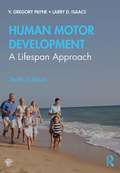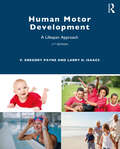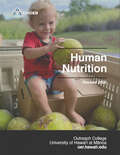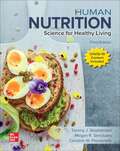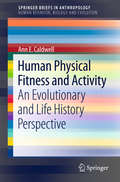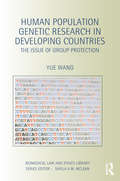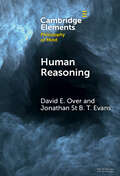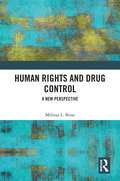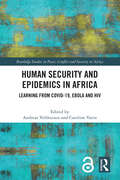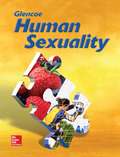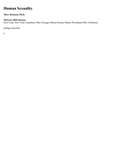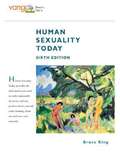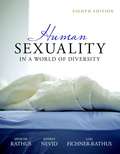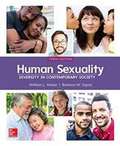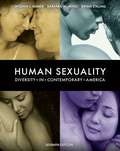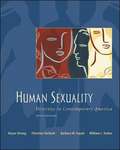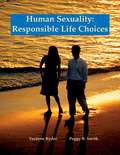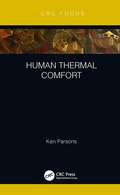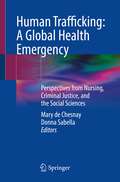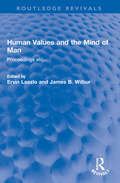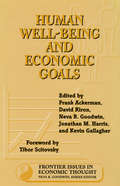- Table View
- List View
Human Motor Development: A Lifespan Approach
by Greg Payne Larry IsaacsHuman Motor Development: A Lifespan Approach, 10th Edition, offers an overview to the study of changes in human movement across the lifespan. The book uses a holistic approach and emphasizes the importance of intellectual, social, and physical development and their impact on human motor development at all ages. The tenth edition has been completely revised and updated to reflect the most recent research and technology in human motor development. Organized into five parts, the book examines key topics in motor development including the relationship between cognitive and social development and motor development, factors affecting development, changes across the lifespan, and assessment in motor development. Highly illustrated and written for student accessibility, Human Motor Development: A Lifespan Approach is essential reading for students of motor control and development, kinesiology, human performance, and students interested in physical therapy, physical education, and exercise science. The book also provides access to a fully updated companion website, which includes laboratory exercises, an instructors’ manual, a test bank, and lecture slides.
Human Motor Development: A Lifespan Approach
by V. Gregory Payne Larry D. IsaacsHuman Motor Development: A Lifespan Approach, Eleventh Edition provides an overview of the academic field of study known as human motor development, the examination of lifelong changes in human movement. The book uses a holistic approach and emphasizes the importance of intellectual, social, and physical development and their impact on human motor development at all ages. The unique approach of this book includes the relationships between motor development and critical interactions with cognitive, social, and physical changes across the lifespan.Organized into five parts, the book examines key topics in motor development, including the relationship between cognitive and social development and motor development, factors affecting development, changes across the lifespan, and assessment in motor development, with special attention being applied to adulthood and older adulthood, given the increasing numbers of people in those age groups worldwide. Each chapter includes chapter objectives, a summary, a list of key concepts, questions for reflection, a list of related online resources, and an extensive reference list.Highly illustrated and written for student accessibility by providing access to a fully updated companion website, which includes laboratory exercises, an instructors’ manual, a test bank, and lecture slides, Human Motor Development: A Lifespan Approach is essential reading for students of motor control and development, kinesiology, and human performance and for students interested in physical therapy, physical education, and exercise science.
Human Nutrition
by University of Hawai‘i at Mānoa Food ScienceThis textbook serves as an introduction to nutrition for undergraduate students and is the OER textbook for the FSHN 185 The Science of Human Nutrition course at the University of Hawai'i at Mānoa. The book covers basic concepts in human nutrition, key information about essential nutrients, basic nutritional assessment, and nutrition across the lifespan. <p><p>Revised 2022
Human Nutrition: Science for Healthy Living
by Tammy J. Stephenson Megan Sanctuary Caroline PasserrelloHuman Nutrition: Science for Healthy Living is an interesting, engaging, reliable, and evidence-based introductory textbook with a wide variety of features to promote active learning. A clinical emphasis appeals to all, but is of particular relevance to those studying nutrition, dietetics, or health science professions, including nursing. Real-life and clinical examples, statistics, and evidence from professional sources address current and controversial topics and support the key concepts of the science of nutrition.
Human Physical Fitness and Activity
by Ann E. CaldwellThe science of human physical activity and fitness is ripefor a novel theoretical framework that can integrate the ecological, genetic,physiological and psychological factors that influence physical activity inhumans. Physical inactivity dominates most developed nations around theworld, and is among the leading causes of disease burden and death worldwide. Despitethe wide array of physical and mental health benefits, few people get therecommended level of physical activity to achieve these benefits. Currentresearch on physical activity has not, as of yet, been successful for thedevelopment of effective exercise interventions. Several researchers haveadvocated a more integrative approach that takes evolutionary history intoaccount, but such a framework has yet to be advanced. To that aim, the firstgoal of this book is to present a comprehensive evolutionary and life historyframework that highlights the domain-specific aspects of the evolved psychologyand physiology that can lead to a more integrated and complete understanding ofphysical activity across the lifespan. It summarizes and extends previous workthat has been done to understand the ways natural selection has shaped physicalactivity in humans in traditional and modern economies and environments. In many ways, humans are adaptedto be physically active. Overall, however, natural selection has shaped aflexible, but energy conscious system that responds to environmental andindividual costs and benefits of physical activity to optimally allocate afinite energetic budget across the lifespan. This system is adapted to respondto cues of resource scarcity and high levels of obligatory physical activity, andconserves energy to favor allocation in ways that increase the likelihood ofreproductive success and survival. This nuanced application leads to a morethorough understanding of the circumstances that natural selection is predictedto favor both sedentary and active behaviors in predictable ways across thelifespan. The second goal of this book is to synthesizeand interpret cross-disciplinary research (from biological and evolutionaryanthropology and psychology; epidemiology; health psychology; and exercisephysiology) that can illuminate original approaches to increase physicalactivity in modern, primarily sedentary contexts. This includes a breakdown ofthe human lifespan to discuss the predicted costs and benefits of physicalactivity at each stage of life in order to differentiate the obstacles tophysical activity and exercise that are functionally adaptive--or were in theenvironments that they evolved--and identifying which factors are moremodifiable than others in order to develop interventions and environments thatare more conducive to physical activity. Normal 0 false false false EN-US JA X-NONE /* Style Definitions */ table. MsoNormalTable {{mso-style-name:"Table Normal"; mso-tstyle-rowband-size:0; mso-tstyle-colband-size:0; mso-style-noshow:yes; mso-style-priority:99; mso-style-parent:""; mso-padding-alt:0in 5. 4pt 0in 5. 4pt; mso-para-margin-top:0in; mso-para-margin-right:0in; mso-para-margin-bottom:10. 0pt; mso-para-margin-left:0in; line-height:115%; mso-pagination:widow-orphan; font-size:11. 0pt; font-family:"Calibri","sans-serif"; mso-ascii-font-family:Calibri; mso-ascii-theme-font:minor-latin; mso-hansi-font-family:Calibri; mso-hansi-theme-font:minor-latin; mso-bidi-font-family:"Times New Roman"; mso-bidi-theme-font:minor-bidi;}}
Human Population Genetic Research in Developing Countries: The Issue of Group Protection (Biomedical Law and Ethics Library)
by Yue WangHuman population genetic research (HPGR) seeks to identify the diversity and variation of the human genome and how human group and individual genetic diversity has developed. This book asks whether developing countries are well prepared for the ethical and legal conduct of human population genetic research, with specific regard to vulnerable target group protection. The book highlights particular issues raised by genetic research on populations as a whole, such as the potential harm specific groups may suffer in genetic research, and the capacity for current frameworks of Western developed countries to provide adequate protections for these target populations. Using The People’s Republic of China as a key example, Yue Wang argues that since the target groups of HPGR are almost always from isolated and rural areas of developing countries, the ethical and legal frameworks for human subject protection need to be reconsidered in order to eliminate, or at least reduce, the vulnerability of those groups. While most discussion in this field focuses on the impact of genetic research on individuals, this book breaks new ground in exploring how the interests of target groups are also seriously implicated in genetic work. In evaluating current regulations concerning prevention of harm to vulnerable groups, the book also puts forward an alternative model for group protection in the context of human population genetic research in developing countries. The book will be of great interest to students and academics of medical law, ethics, and the implications of genetic research.
Human Reasoning (Elements in Philosophy of Mind)
by David E Over Jonathan St EvansThis Element is on new developments in the psychology of reasoning that raise or address philosophical questions. In traditional studies in the psychology of reasoning, the focus was on inference from arbitrary assumptions and not at all from beliefs, and classical binary logic was presupposed as the only standard for human reasoning. But recently a new Bayesian paradigm has emerged in the discipline. This views ordinary human reasoning as mostly inferring probabilistic conclusions from degrees of beliefs, or from hypothetical premises relevant to a purpose at hand, and as often about revising or updating degrees of belief. This Element also covers new formulations of dual-process theories of the mind, stating that there are two types of mental processing, one rapid and intuitive and shared with other animals, and the other slow and reflective and more characteristic of human beings. The final topic covered is the new developments and rationality.
Human Rights and Drug Control: A New Perspective
by Melissa L. BoneThis book uses a human rights perspective – developed philosophically, politically and legally – to change the way in which we think about drug control issues. The prohibitionist approach towards tackling the ‘drugs problem’ is not working. The laws and mentality that see drugs as the problem and tries to fight them, makes the ‘drugs problem’ worse. While the law is the best-placed mechanism to regulate our actions in relation to particular drugs, this book argues against the stranglehold of the criminal law, and instead presents a human rights perspective to change the way we think about drug control issues. Part I develops a conceptual framework for human rights in the context of drug control – philosophically, politically and legally – and applies this to the domestic (UK) and international drug control system. Part II focuses on case law to illustrate both the potential and the limitations of successfully applying this unique perspective in practice. The conclusion points towards a bottom-up process for drug policy which is capable of reconfiguring the mentality of prohibition. This book will be of interest to students and scholars of human rights, criminal law, criminology, politics and socio-legal studies.
Human Security and Epidemics in Africa: Learning from COVID-19, Ebola and HIV (Routledge Studies in Peace, Conflict and Security in Africa)
by Caroline Varin Velthuizen, Edited by AndreasThis book examines the impact of epidemics in Africa, exploring some of the adaptation and crisis management strategies adopted to tackle COVID-19, Ebola, and HIV-AIDS. The authors reflect on lessons learned from solving complex problems and difficult decisions made by leaders on pandemic management to shape the security environment and, thus, the well-being of people living in Africa for years to come.Drawing on cases from across the continent, the book demonstrates that, significantly, during the COVID-19 pandemic, African countries and communities frequently displayed regional solidarity, creativity in decision-making, decisiveness in dealing with corruption and opportunism, and resilience and discipline in implementation. Adopting a human security framework, the authors share their lived experiences and explore the impact of epidemics on public policy decision-making, foreign policy implementation, global relations, collaboration in the community dimension, and, ultimately, the future of socio-economic development in Africa.This book will be a welcome addition for practitioners and researchers across the fields of security studies, health management, and African studies, making an essential contribution to the security discourse in a post-COVID world.
Human Sexuality
by Mary BronsonHigh School sex education textbook contents: Sexuality and you Relationships and choosing abstinence The reproductive system Marriage and parenthood Pregnancy and childbirth Issues of sexuality Sexually transmitted diseases HIV and AIDS
Human Sexuality Today (6th Edition)
by Bruce M. KingThe sixth edition of Human Sexuality Today provides students with the information they need to make responsible decisions and helps them feel comfortable about themselves while learning about their sexuality.
Human Sexuality in a World of Diversity (8th Edition)
by Lois Fichner-Rathus Jeffrey S. Nevid Spencer A. RathusHuman Sexuality in a World of Diversity, 8e examines the rich diversity found in human sexuality and helps students develop their own opinions by promoting critical thinking skills, personal sexual health awareness, and responsible decision-making. Firmly rooted in science, the text systematically encourages students to apply the research to their own lives.
Human Sexuality in a World of Diversity (Ninth Edition)
by Lois Fichner-Rathus Spencer A. Rathus Jeffrey S NevidHuman Sexuality in a World of Diversity, 9/e examines the rich diversity found in human sexuality. More significantly, the text places an emphasis on cultivating understanding in a world of increasing diversity through personal engagement. Students are encouraged to reflect upon their own beliefs and experiences throughout the text in order to foster a more personal and impactful learning experience. The text also helps students develop their own opinions by promoting critical thinking skills, personal sexual health awareness, and responsible decision-making.
Human Sexuality in a World of Diversity 5th ed.
by Lois Fichner-Rathus Jeffrey S. Nevid Spencer A. RathusDetailed discussion of human sexuality.
Human Sexuality: Diversity In Contemporary Society
by Barbara W. Sayad William L YarberHuman Sexuality: Diversity in Contemporary Society continues to be a pioneering text in many ways. The sexual affirmation approach encourages students to become proactive in and about their own sexual well-being and includes an emphasis on the importance of embracing intimacy, pleasuring, and mutual satisfaction in sexual expression. It also strives to represent the contemporary, diverse society that students encounter inside and outside the classroom. <P><p>And with McGraw-Hill Education Connect for Human Sexuality, students embark on a personalized digital learning program, which allows them to study more effectively and efficiently. Each chapter contains multiple Think About It features that prompt students to think critically about topics in sexuality such as am I normal, the science of love, hooking up, what behaviors constitute having had sex, orgasm and pleasure, and how college students indicate and interpret consent to have sex. The Practically Speaking feature asks students to examine their own values and the ways they express their sexuality. Topics include sexual communication, effective condom use, having sex again after sexual assault, and a glossary on sex, gender, and gender variation terms. These features help students apply the concepts presented in the book to their own lives.
Human Sexuality: Diversity in Contemporary America (8th Edition)
by Bryan Strong William Yarber Barbara SayadHuman Sexuality: Diversity in Contemporary America presents a forward thinking, open approach to Human Sexuality for today's student. The new lead authors, Bill Yarber and Barbara Sayad, continue to bring their research experience to the book while maintaining the engaging writing style that original author Bryan Strong brought to this best-selling text for years. The first text to achieve a full integration of cutting-edge research with a contemporary "sex-positive" approach, it also strives to represent the modern, diverse world that students encounter outside the classroom. Both within the text itself and throughout the exemplary art and photo program, the focus is on inclusion. Human Sexuality has been lauded by students and instructors alike for providing the most integrated and non-judgmental view of sexual orientation available. The eighth edition maintains these themes while adding a new contemporary design, streamlined format and significant content and feature revisions and updates.
Human Sexuality: Diversity in Contemporary America (Seventh Edition)
by Bryan Strong William L. Yarber Barbara J. SayadHuman Sexuality: Diversity in Contemporary America presents a forward thinking, open approach to Human Sexuality for today's student. The new lead authors, Bill Yarber and Barbara Sayad, continue to bring their research experience to the book while maintaining the engaging writing style that original author Bryan Strong brought to this best-selling text for years. The first text to achieve a full integration of cutting-edge research with a contemporary"sex-positive"approach, it also strives to represent the modern, diverse world that students encounter outside the classroom. Both within the text itself and throughout the exemplary art and photo program, the focus is on inclusion. Human Sexuality has been lauded by students and instructors alike for providing the most integrated and non-judgmental view of sexual orientation available. The seventh edition maintains these themes while adding a new contemporary design, streamlined format and significant content and feature revisions and updates.
Human Sexuality: Diversity in Contemporary America 5th ed.
by Bryan Strong Christine Devault Barbara W. Sayad William L. YarberA non-judgmental introduction to human sexuality that features integration of ethnic, cultural, gender, and sexual orientation differences and similarities.
Human Sexuality: Making Informed Decisions
by David Knox Caroline Schacht Mark A WhatleyProvides an understanding of the human reproductive system, the various factors that influence the sexual decisions that every individual make and guides us to making the right sexual decision putting into consideration all the outcomes/consequences of every option. The book lets us know we have a deliberate choice to make in a relationship, a healthy choice for both the body and mind.
Human Sexuality: Responsible Life Choices
by Verdene Ryder Peggy B. SmithProvides teenage readers with basic information about sexual development and reproductive health. Chapters explain the sexual decision-making process and examine the outcomes and risks of sexual activity. Annotation c. by Book News, Inc., Portland, OR.
Human Thermal Comfort
by Ken ParsonsThermal comfort is a desirable state familiar to all people. Providing inspirational indoor and outdoor environments that provide thermal comfort, in the context of energy use and climate change, is a challenge for the 21st century. This book provides an up-to-date, comprehensive coverage of thermal comfort from principles and theory to practical application. The book begins with current knowledge and understanding of thermal comfort and its application to providing thermal conditions for indoor and outdoor environments. It integrates and presents new ideas to provide a comprehensive model of thermal comfort so that we can move on from the 20th and early 21st century and provide a focus for developments for future decades. This book will be of interest to practitioners and students and anyone involved with fields such as environmental design, physiology, ergonomics, human factors, industrial hygiene, architecture, health and safety and air conditioning. • Provides current thermal comfort standards and regulations • Describes the PMV, PPD, ET* and SET thermal comfort indices • Discusses adaptive thermal comfort, adaptive opportunity and explains why we have not moved towards a more dynamic and interactive approach to providing thermal comfort • Presents a new model relating thermal discomfort to performance • Shows how to construct a computer model of thermal comfort • Offers how to conduct a thermal comfort survey Human Thermal Comfort provides new ideas for achieving thermal comfort for offices, vehicles, atriums, and plazas of the future.
Human Trafficking: Perspectives from Nursing, Criminal Justice, and the Social Sciences
by Donna Sabella Mary De ChesnayThis book presents various forms of human trafficking, a growing trend in the exploitation of large numbers of people with concurrent public health, socio-cultural, and economic costs to countries burdened with the consequences of the COVID-19 pandemic. Edited by psychiatric-mental health nurses and an applied anthropologist, this volume covers all forms of human trafficking: sex trafficking, forced labor, forced marriage, baby trafficking, organ trafficking, child marriage, and child soldiers with a global public health and policy focus. As such, it fills a gap in human trafficking knowledge and is built on courses springing up around the United States in multiple disciplines. Medical, mental health, and social work interventions are included as well as information about programs with documented outcomes. Each chapter includes state of the art of knowledge with case studies illustrating specific focal ideas, discussion, questions and exercises in order to help readers retain and reinforce chapter material. This textbook will be useful in the disciplines of nursing, medicine, public health, social work, and policy making, as well as in disciplines in which human trafficking is a current interest, such as law, criminal justice, and education.
Human Values and the Mind of Man: Proceedings etc... (Routledge Revivals)
by Ervin Laszlo James B. WilburFirst Published in 1971, Human Values and the Mind of Man examines how value questions have been treated in traditional theories of human nature. It discusses the following topics: theory of mind as seen through the rules of the generation of languages; the implications for human value of automata theory; the nervous system, higher mental processes and human values; value consequences of various positions on the mind-body problem; the implications of self-actualization theory for human value; and specific value problems in the philosophy of mind. The book presents an interdisciplinary dialogue centred around thoughts about man and their implications for human action, decision, and nature of what we call the ‘human mind’. This book is an essential read for philosophers, psychologists, scientists, and humanists.
Human Well-Being and Economic Goals (Frontier Issues in Economic Thought #3)
by Kevin Gallagher Jonathan Harris Neva R. Goodwin David Kiron Frank Ackerman Kenneth ArrowWhat are the ends of economic activity? According to neoclassical theory, efficient interaction of the profit-maximizing "ideal producer" and the utility-maximizing "ideal consumer" will eventually lead to some sort of social optimum. But is that social optimum the same as human well-being? Human Well-Being and Economic Goals addresses that issue, considering such questions as: *Does the maximization of individual welfare really lead to social welfare? *How can we deal with questions of relative welfare and of equity? *How do we define, or at least understand, individual and social welfare? *And how can these things be measured, or even assessed? Human Well-Being and Economic Goals brings together more than 75 concise summaries of the most significant literature in the field that consider issues of present and future individual and social welfare, national development, consumption, and equity. Like its predecessors in the Frontier Issues in Economic Thought series, it takes a multidisciplinary approach to economic concerns, examining their sociological, philosophical, and psychological aspects and implications as well as their economic underpinnings. Human Well-Being and Economic Goals provides a powerful introduction to the current and historical writings that examine the concept of human well-being in ways that can help us to set goals for economic activity and judge its success. It is a valuable summary and overview for students, economists, and social scientists concerned with these issues.
